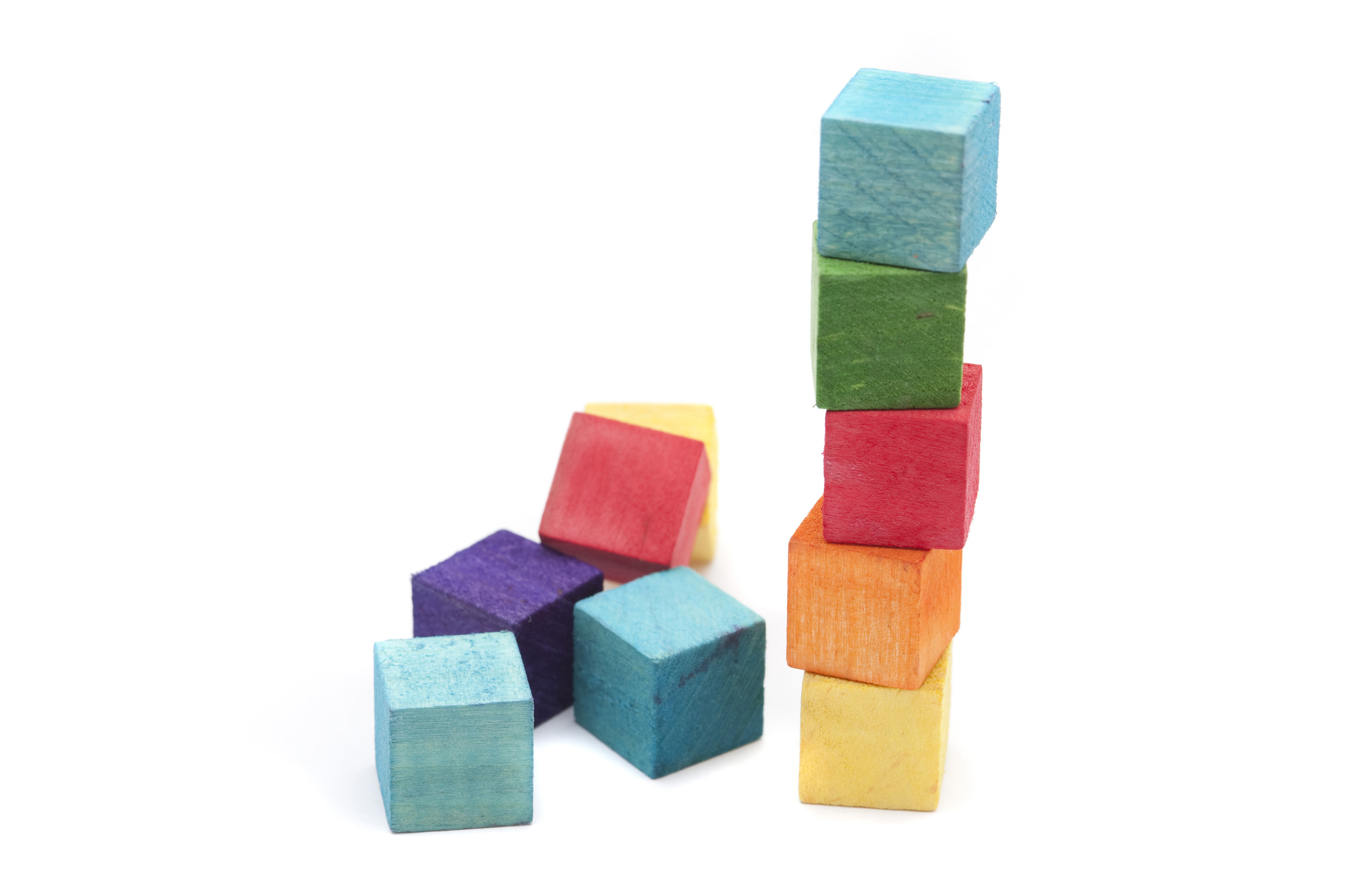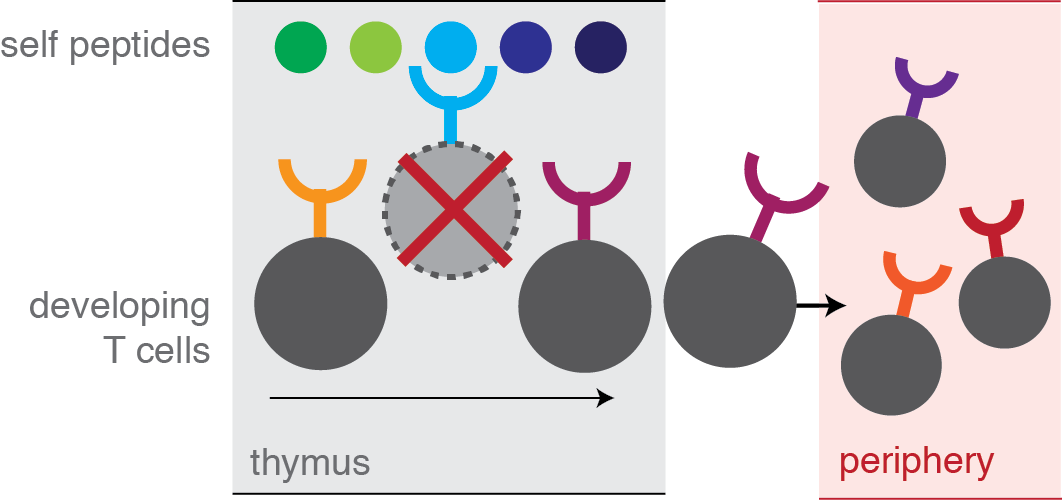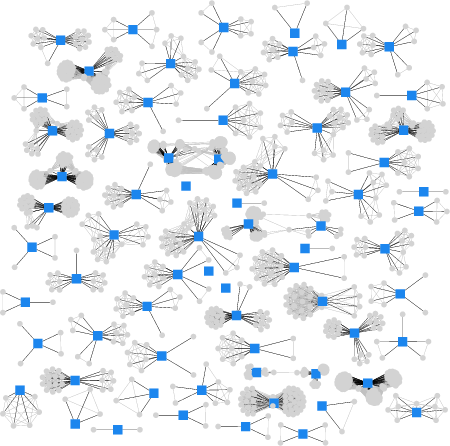Natural Computing, 23-02-2021
Is T-Cell Negative Selection a
Learning Algorithm?
Inge Wortel
inge.wortel@ru.nl
Data Science, Radboud University


T cells

Adapted from National Cancer Institute (NIH)
- Adaptive immune system
- Specific responses against pathogen-infected or cancerous cells
- T-cell receptor (TCR) recognizes short peptides on MHC
- Compromised (infected/cancerous) cells display different peptides than healthy cells do
T-cell diversity & negative selection: a problem of numbers
The immune system's T-cell repertoire must discriminate "self" vs "foreign":
- recognize >1015 foreign peptides ... 1
- ... while tolerating hundreds of thousands of self peptides


1 Sewell (2012). Nature Reviews Immunology.
T-cell diversity & negative selection: a problem of numbers
The immune system's T-cell repertoire must discriminate "self" vs "foreign":
- recognize >1015 foreign peptides ... 1
- ... while tolerating hundreds of thousands of self peptides
Diversity: random TCR

Tolerance: negative selection

1 Sewell (2012). Nature Reviews Immunology.
Let's vote:
Is achieving "self-tolerance" the same as
achieving "self-foreign discrimination"?
Does negative selection achieve tolerance?

Healthy humans have many self-reactive T cells! 1

$\rightarrow$ Negative selection is incomplete!
1 Yu et al. (2015). Immunity.
Tolerance and discrimination are not the same thing
Tolerance and discrimination are not the same thing
Which of these scenarios holds?
Given that negative selection is incomplete, can T cells distinguish
between self and foreign peptides they haven't seen
in the thymus?
Can you see the difference between English and Xhosa?
ceived kuqale erness
kubang lwaban rkness
ceived kuqale erness
kubang lwaban rkness
Which of these scenarios holds?
Can T cells distinguish between self and foreign peptides they
haven't seen
in the thymus?
Which of these scenarios holds?
Can T cells learn by example during negative selection?
- in principle?
- in our immune system?
Approach: Artificial Immune System (AIS)
Use AIS to investigate the purpose of incomplete negative selection:
- Make repertoires with millions of TCRs
- Simulate negative selection in silico
- Can handle multiple types of input data:
both languages and peptides
A simple model of TCR-sequence recognition
Three ingredients needed:
| 1 | Sequence | |
| 2 | TCR | |
| 3 | Affinity |
A simple model of TCR-sequence recognition
Three ingredients needed:
| 1 | Sequence | 6-letter strings of text in a certain language |
| 2 | TCR | |
| 3 | Affinity |
A simple model of TCR-sequence recognition
Three ingredients needed:
| 1 | Sequence | 6-letter strings of text in a certain language |
| 2 | TCR | binding motif |
| 3 | Affinity |
A simple model of TCR-sequence recognition
Three ingredients needed:
| 1 | Sequence | 6-letter strings of text in a certain language |
| 2 | TCR | binding motif |
| 3 | Affinity | Longest stretch of adjacent "matches" $\rightarrow$ binding if affinity $\geq$ threshold t |
Simulating negative selection in silico
Example: Xhosa recognition after negative selection on English
Negative selection allows discrimination
Negative selection on 500 English strings (t = 3),
Compare recognition of different English and Xhosa strings
| Motifs per string, before vs after: | Most frequently recognized: |
$\rightarrow$ Motifs distinguish strings they have not seen!
Why discrimination on unseen strings?
Motifs rarely react to both English and Xhosa:
Nodes:
- English
- Xhosa
Edge if >10,000 motifs in common
Concordance (same-language neighbors): 81%
Why discrimination on unseen strings?
This only works if strings are truly different:
Nodes:
- English
- More English
Edge if >10,000 motifs in common
Concordance (same-language neighbors): 50%
Two key requirements for self-foreign discrimination
- Appropriate specificity/cross-reactivity
- Sufficient self-foreign dissimilarity
Two key requirements for self-foreign discrimination
- Appropriate specificity/cross-reactivity
- Sufficient self-foreign dissimilarity
| Complete specificity (t = 6) | Low specificity (t = 1) | Intermediate specificity (t = 3) |
Two key requirements for self-foreign discrimination
- Appropriate specificity/cross-reactivity
- Sufficient self-foreign dissimilarity
Summary: what have we learned from languages?
Proof of concept:
Negative selection can foster "learning by example".
- Self-foreign discrimination even on "unseen" sequences
- Even when tolerance is incomplete
But this works only if:
- self and foreign are sufficiently dissimilar
- cross-reactivity is intermediate
Back to self versus foreign peptides
Back to self versus foreign peptides
Use the same model for peptides instead of strings:
Peptides from "self" and "foreign" proteomes are similar
Peptides from "self" and "foreign" proteomes are similar

HIV peptides are embedded in
clusters of self peptides.
Xhosa/English: separate clusters.
$\rightarrow$ self-foreign discrimination will be difficult!
Self-foreign discrimination is difficult
... but remains possible:
What if thymic self peptides are non-random?
- random self peptides are often similar and will delete the same TCRs
$\rightarrow$ this is inefficient - some peptides are exchangeable, others are not
$\rightarrow$ a training set with more non-exchangeable peptides might do better:
"Optimal" training peptides improve self-foreign discrimination
Removal of self-reactivity $\neq$ self-foreign discrimination! Why does this work?
Why better self-foreign discrimination?
Self peptides with low exchangeability less often resemble foreign peptides:
$\rightarrow$ non-exchangeable peptides efficiently remove self-reactive TCRs, but preserve foreign-reactive ones!
How could the thymus be "optimal"?
Computed "optimal" set is enriched in rare AAs, depleted of common AAs.
Peptides with rare AAs tend to be less exchangeable:
$\rightarrow$ Could enrichment of rare AAs help self-foreign discrimination?
How could the thymus be "optimal"?
Choose "training" self peptides with a bias for peptides with rare AAs:
Simple bias already improves self-foreign discrimination.
The same is true for other pathogens
- Poor self-foreign discrimination after selection on random peptides
- Improved self-foreign discrimination after selection on biased peptides
Self-foreign dissimilarity is no longer necessary
Randomly split the self peptides into "self" and "foreign":
$\rightarrow$ T cells can discriminate, no matter how much a virus resembles self!
Summary: self-foreign discrimination in the immune system

Negative selection allows "learning by example"
- Even incomplete negative selection can allow T cells
to discriminate "self" from "foreign" in principle. - This reconciles textbook theory with
surprising experimental data. - ...And it shows that our brain is not the only
organ that can learn!
...but self-foreign discrimination is hard:
- high self-foreign similarity hampers discrimination after selection
- Prediction: we can overcome this with training peptides biased for rare AAs
$\rightarrow$ because of AA bias in peptide presentation pathway?
Acknowledgements
Tumor Immunology, Nijmegen
- Johannes Textor
- Jolanda de Vries
- Carl Figdor
- Human DLM
Funding
- Radboudumc PhD grant
Theoretical Biology, Utrecht
- Rob de Boer
- Can Keşmir
Physiology, McGill University Montreal
- Judith Mandl

